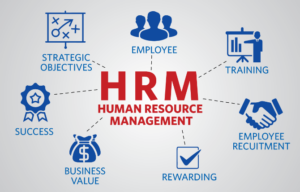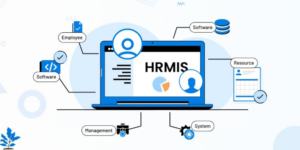HR Management Systems for Businesses – Streamline your HR processes with modern HR management systems (HRMS). Whether you’re a small business or a large enterprise, choosing the right HR software can save time, improve efficiency, and reduce compliance risks. In this guide, we’ll walk you through the top options, their features, and how they benefit your business.
What is an HR Management System?

An HR management system (HRMS) is software designed to manage human resource tasks such as recruitment, employee tracking, payroll, benefits administration, and performance management. It simplifies HR functions by automating processes, keeping data secure, and providing analytics to make informed decisions.
Key Benefits of HR Management Systems
HR management systems (HRMS) provide a wide range of benefits that help businesses optimize their human resource operations. Here are some of the key advantages:
1. Automation of Repetitive Tasks
HRMS automates time-consuming and repetitive tasks such as payroll processing, attendance tracking, and performance evaluations. By reducing the need for manual data entry and paperwork, your HR team can focus on more strategic initiatives, improving overall efficiency.
- Example: Instead of manually processing timesheets, an HRMS can automatically calculate hours worked, including overtime, and prepare payroll with minimal intervention.
2. Improved Accuracy and Compliance
Manual HR tasks are prone to human error, especially when it comes to payroll and compliance. HRMS ensures accurate calculations for salaries, taxes, and benefits, reducing the likelihood of costly mistakes. Many systems also come with compliance management tools to help businesses adhere to labor laws and regulations, minimizing the risk of legal issues.
- Example: ADP Workforce Now has a compliance feature that keeps track of changes in tax laws and ensures that payroll is processed correctly according to regulations.
3. Enhanced Employee Experience
Employees benefit from self-service portals where they can update personal information, apply for leave, check pay stubs, and view their benefits. This reduces the burden on HR departments and increases employee satisfaction, as they have more control over their own information.
- Example: BambooHR’s employee self-service portal allows staff to view their work schedule, request time off, and access important company documents without needing to contact HR.
4. Data-Driven Decision Making
HRMS provides real-time analytics and reporting tools, giving HR managers valuable insights into employee performance, attendance, turnover rates, and more. With this data, companies can make informed decisions about hiring, training, promotions, and workforce planning.
- Example: Workday HCM offers advanced reporting and analytics, helping businesses monitor KPIs like employee retention and identify areas for improvement.
5. Cost Savings and Increased Productivity
By automating HR processes and reducing manual tasks, HRMS can significantly cut down on administrative costs. The streamlined operations lead to improved productivity across HR departments, as they can focus on strategic goals rather than routine tasks.
- Example: Zoho People’s automation of time tracking, performance reviews, and employee onboarding reduces the need for dedicated administrative staff, saving both time and money.
6. Centralized Data Management
HRMS centralizes employee data in one secure, cloud-based system, making it easier to access and manage. It eliminates data silos, ensuring that all HR information is up-to-date and available to relevant stakeholders. This also enhances security by limiting access to sensitive information based on roles and permissions.
- Example: Gusto securely stores employee records, payroll data, and benefits information in one system, allowing HR managers to access it from anywhere while ensuring that sensitive data is protected.
7. Improved Recruitment and Onboarding
Many HRMS platforms offer recruitment and onboarding tools that streamline the hiring process. These tools can post job openings, screen applicants, schedule interviews, and onboard new employees, making it easier to attract and retain top talent.
- Example: BambooHR’s applicant tracking system (ATS) helps businesses manage job postings, track applications, and communicate with candidates, speeding up the hiring process
Top 5 HR Management Systems for Businesses

Below are the five best HR management systems for businesses, each offering unique features and benefits.
1. BambooHR
BambooHR is a cloud-based HRMS that simplifies HR operations for small to medium-sized businesses. It provides tools for employee self-service, time tracking, and applicant tracking systems (ATS).
Key Features:
- Employee self-service portal
- Performance management tools
- Built-in ATS
- Time-off tracking
- Payroll integration
Price: Starts at $99/month for up to 12 employees.
Use Case: Best for small to medium-sized businesses looking for an all-in-one HR solution.
2. Workday HCM
Workday HCM offers a full suite of tools for larger businesses, integrating HR management, payroll, and talent management into one platform.
Key Features:
- Unified payroll and HR system
- Real-time analytics
- Mobile access
- Workforce planning
- Learning management system (LMS)
Price: Custom pricing based on company size.
Use Case: Ideal for enterprises that require advanced functionality and scalability.
3. Gusto
Gusto is a cloud-based HRMS designed specifically for small businesses, providing payroll, benefits, and time tracking tools in one affordable package.
Key Features:
- Full-service payroll
- Employee benefits management
- Time tracking
- Onboarding and compliance tools
- Tax filing automation
Price: Starts at $40/month, plus $6/employee.
Use Case: Best suited for small businesses looking to streamline payroll and compliance tasks.
4. Zoho People
Zoho People is an affordable, highly customizable HR management system with an emphasis on employee engagement and performance tracking.
Key Features:
- Attendance management
- Custom workflows
- Employee performance tracking
- Self-service portal
- Recruitment management
Price: Starts at $1 per employee per month.
Use Case: Great for businesses that want a customizable HR system with an emphasis on employee engagement.
5. ADP Workforce Now
ADP Workforce Now is a robust HRMS platform suitable for businesses of all sizes, offering payroll, benefits administration, and talent management.
Key Features:
- Comprehensive payroll and tax solutions
- Talent acquisition and management
- Time and attendance tracking
- Compliance tools
- Benefits administration
Price: Custom pricing based on business needs.
Use Case: Perfect for businesses seeking an enterprise-grade HRMS with a wide range of functionalities.
Comparison Table: Best HR Management Systems for Businesses
| HRMS | Best For | Key Features | Pros | Cons | Price |
|---|---|---|---|---|---|
| BambooHR | Small to medium businesses | Self-service, ATS, time tracking, payroll | Easy to use, scalable, employee portal | Lacks advanced analytics | $99/month |
| Workday HCM | Large enterprises | Unified HR/payroll, analytics, LMS | Comprehensive, scalable, mobile access | Expensive for small businesses | Custom pricing |
| Gusto | Small businesses | Payroll, benefits, compliance, onboarding | Affordable, tax automation, easy payroll | Limited in-depth HR features | $40/month + $6/employee |
| Zoho People | Customization & engagement focus | Attendance, performance, recruitment | Customizable, affordable, mobile access | Fewer advanced payroll features | $1/employee/month |
| ADP Workforce Now | All business sizes | Payroll, benefits, time tracking, talent | Full payroll services, compliance tools | Higher learning curve, costly | Custom pricing |
How to Choose the Best HR Management System for Your Business

Selecting the right HR Management System (HRMS) for your business is a crucial decision that can impact your company’s productivity, compliance, and overall employee experience. Here’s a step-by-step guide to help you make an informed choice:
1. Identify Your HR Needs and Challenges
Before diving into the selection process, it’s essential to understand the specific HR challenges your business faces. What processes are you trying to streamline? Do you need help with recruitment, performance management, payroll, or employee self-service?
- Example: If your HR team is overwhelmed with manual payroll calculations, then an HRMS with strong payroll automation features would be a priority.
2. Consider the Size of Your Business
The needs of a small business with 20 employees will differ greatly from those of a large enterprise with 1,000+ employees. Some HRMS solutions are designed specifically for small businesses, while others are better suited for mid-sized and large corporations. Make sure the HRMS you choose can scale with your business as it grows.
- Example: A startup may benefit from a simpler solution like Zoho People, while a larger corporation might require the comprehensive capabilities of Workday HCM.
3. Evaluate Key Features
Every HRMS offers a variety of features, but which ones are essential for your business? Here are some critical features to consider:
- Payroll Automation: Automate salary calculations, tax deductions, and direct deposits.
- Time and Attendance Tracking: Monitor employee hours and manage shifts.
- Recruitment & Applicant Tracking: Streamline the hiring process with job postings and candidate tracking.
- Performance Management: Set goals, conduct reviews, and track employee progress.
- Employee Self-Service: Allow employees to update their details, check payslips, and request time off.
Consider your top priorities and choose an HRMS that offers these features.
4. Ensure Compliance Features
Managing compliance with labor laws, tax regulations, and employee benefits can be challenging, especially as your business grows. Choose an HRMS that offers tools to help maintain compliance with local, state, and federal regulations. This is especially important for businesses with operations in multiple locations or those planning to scale globally.
- Example: ADP Workforce Now has built-in compliance tools that ensure tax filings and benefits are handled correctly across different regions.
5. User-Friendly Interface
Even the most feature-rich HRMS won’t be effective if it’s too difficult for your HR team and employees to use. Look for systems with an intuitive, user-friendly interface that simplifies tasks rather than complicates them. Demo the software with key stakeholders in your HR department to ensure it’s easy to navigate.
- Example: BambooHR is well-known for its clean, easy-to-use interface, making it ideal for small and medium-sized businesses.
6. Customization and Flexibility
Your business might have unique HR requirements, so look for an HRMS that offers flexibility in customization. Whether it’s personalized reports, custom workflows, or specialized modules, having a system that can adapt to your needs is essential for long-term success.
- Example: Zoho People allows businesses to customize workflows, forms, and fields to fit their specific HR processes.
7. Integration Capabilities
Does your HRMS need to integrate with other software, like accounting tools, CRM systems, or third-party benefits providers? Make sure the HRMS you choose offers integration capabilities with other essential business software to ensure smooth data flow and communication between systems.
- Example: Workday HCM integrates with many financial and operational systems, offering a seamless connection between HR and other business functions.
Benefits of Using HR Management Systems
Using an HR management system can revolutionize the way your business handles human resources. Some of the key benefits include:
- Reduced Manual Errors: Automating payroll and time tracking reduces the risk of human error.
- Improved Employee Experience: Employees can access their own information, apply for time off, and see their benefits without needing to contact HR.
- Better Compliance: Many HRMSs come with built-in compliance management to ensure your business stays up-to-date with labor laws.
- Cost Savings: Automating tasks means fewer resources are needed for administrative work, saving your business money in the long run.
- Data-Driven Decisions: HRMS systems provide analytics that allow businesses to make informed decisions regarding workforce management.
Where to Buy and How to Purchase HR Management Systems
Ready to purchase an HR management system for your business? Here’s how you can buy from each provider:
- BambooHR: Visit the official BambooHR website to explore pricing and request a demo.
- Workday HCM: Head to the Workday HCM website to get custom pricing and schedule a consultation.
- Gusto: Sign up on the Gusto website for a free trial or to get started with one of their plans.
- Zoho People: Go to Zoho People to see pricing details and start a free trial.
- ADP Workforce Now: Visit the ADP Workforce Now site to request a demo and get a custom quote for your business.
Frequently Asked Questions (FAQs)
- What is an HR Management System (HRMS)?
An HRMS is software that automates HR tasks like payroll, performance tracking, recruitment, and benefits management. - How do HR management systems improve efficiency?
They reduce manual work by automating repetitive tasks like payroll processing, attendance tracking, and compliance reporting. - What’s the best HR management system for small businesses?
Gusto is a popular choice for small businesses due to its affordability and full-service payroll features. - Are HR management systems scalable?
Yes, systems like Workday HCM and ADP Workforce Now are designed to scale with your business needs. - How much does an HR management system cost?
Prices vary, ranging from $1 per employee per month (Zoho People) to custom pricing for enterprise-level solutions like Workday HCM.
With the right HRMS, you can streamline your human resources tasks, save time, and focus on growing your business.